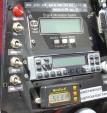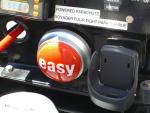|
|
Sunday May 21 through Thursday May 25, 2006A short respiteI flew back to Pennsylvania (via Northwest Airlines) and attended my eldest sons college graduation. Then flew back to Phoenix . Not a lot of sleep, lots of time zone whiplash. Tomorrow we have some media interviews, and on Saturday morning I'm planning on flying what is probably the most dangerous leg of the whole trip. Don't get me wrong, I'm not downplaying the danger of some of the areas already flown. Its easy to see from the photos that the if you don't want to land in it, don't fly over it rule has already been ignored numerous times. But with the exception of some of the relentlessly mountainous areas already traversed, there was usually a way into any area being flown over by use of 4 wheel drive vehicles. The route being flown Saturday includes a true wilderness area called the Tonto National Forest . There are no roads in, no roads out. It rises from 1,000 msl to 6,000 msl. I've been advised that helicopters are the only mode of rescue used in the area. It should be quite an adventure. I have to comment on the Voyagers components. They're working very well. The HKS engine is proving to be a completely reliable power plant, and although Voyager is a bit on the plump side for a 60 hp engine, as long as I'm not in a race, there's no problem. I'm installing a fan on the oil cooler to provide a bit more cooling capacity. The area where the HKS really shines is fuel consumption. At around 3 gallons an hour, it makes 582 owners blush with envy. The Phoenix PPC airframe is also proving out to be a solid and reliable foundation. With the exception of the bent axle from the rather hard landing and sideways push on the first day, the airframe is fantastic, and very comfortable to fly. I really appreciate its stability, especially when plowing through thermals. When I switched to the Performance Designs 550 chute, I expected to fly slower than with the 500. Contrary to popular wisdom, I'm flying faster. How? I don't know. My climb rate has improved, and the chute is easy to handle. All the instrumentation has been working like a charm. The AvMap GPS makes it virtually impossible to get lost. (I still carry a sectional in my kneeboard, and a compass in my pocket.) The ATC people in the towers tell me they aren't quite sure what they're seeing when I pop onto their screens at 30 mph, but they finally figure it out. Its good to know the Garmin Mode C Transponder is doing its job. I'm always interested in my altitude, and I've 4 altimeters on board. The transponder has one, the GPS has one, the Grand Rapids Technology EIS has one, and the MicroTim backs them up. Its interesting to watch and see how close they match. Usually they're within 50 to 100 feet of each other. The is very convenient to use, and it matches the GPS altimeter closer than the other two. Id recommend it to any pilot. The Grand Rapids EIS is my primary source of engine performance and condition. I'm sure there are others available, but in my opinion the GR EIS is tops. Everything I need to know, and stuff I don't need to know! Plus the limits and readouts are all programmable. I like the flexibility. The Vertex radio is great. Unfortunately I'm getting interference in my transmissions from the spark plug RF output, and I'm trying to solve that problem by finding resistor plugs to replace the ones currently installed. Unfortunately there may not be any suitable substitute. I'll know soon. You may notice the single most important piece of equipment on the plane, the EASY button. If everything starts going to heck in a hand basket, all I need do is press it and everything will be fine. At least that's what they show in the commercials. They wouldn't lie, would they? Time for some chow and some sleep. 
|



